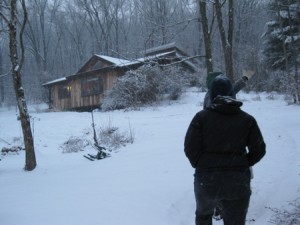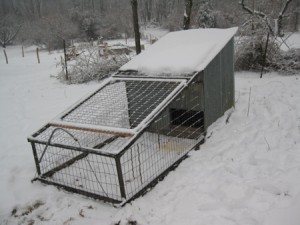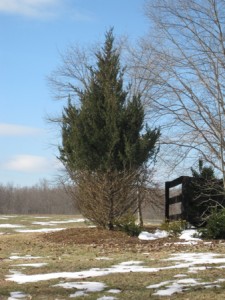Visit to Myers-Benner Homestead
February 2, 2010
Kristin, Lucy, and I visited the Myers-Benner homestead near Harrisonburg to learn more about chickens, gardening, and living sustainably from folks who have had a little more practice than we have.
We contacted Jason and Janelle Myers-Benner several weeks ago to arrange a visit after getting their contact information from my sister, Joni, and her husband, Steve. Jason and Janelle were surprisingly happy to show us around their little farm and even serve us dinner—despite the fact that Kristin and I are so distantly related to them that the word or phrase that best describes our relationship to them is not “second cousin” or “first cousin, once removed” but “stranger.”
When the day finally came for our visit, the threat of (more) snow made us reconsider our visit, but Kristin, Lucy, and I, after much vacillation, decided to go. Jason and Janelle offered to put us up in their home if we couldn’t get back home, and Kristin and I figured that the quantity of snow the National Weather Service predicted would be enough to make driving slow but not impossible, particularly for intrepid former Minnesotans such as ourselves. Unfortunately, Whitney and Matt couldn’t go along as we had originally planned (because Matt actually has a job to which he had to go the next day.
The drive to Keezletown was easy enough, though getting up their upward-sloping, unplowed lane was a little tricky. Luckily, we were stopped before going up a particularly treacherous portion of the lane by a friendly neighbor who told us that the Myers-Benners didn’t live up that branch of the lane. We weren’t too surprised by the driveway because Janelle had asked whether we had a four-wheel-drive vehicle to get up their lane. I like our Prius for many reasons, but a farm vehicle it is not.
Jason and Janelle welcomed us into their cozy, wood-stove-heated home, half of which they had largely rebuilt themselves. Janelle and her daughter, Kali, hit it off with Lucy right away. After getting acquainted a bit, Jason showed us around the farm. Seeing their setup for their chickens was a great help and relief. Many of the resources we had looked at before for raising chickens recommended fairly large, stationary structures for the chickens and required frequent changing of the litter in the coop.
Inspired by Joel Salatin’s methods, Jason had his chickens, roughly thirty in all, in small, portable coops/runs. The coops had a wire mesh floor that allowed the bird droppings to fall right through to the snow covered ground. Jason just dragged each coop a little bit each day, taking the chickens away from potentially diseased droppings and onto fresh pasture. He had adapted the Polyface ideas well for a backyard flock.
After showing the flock to us, Jason showed us his garden space and took us through his “master plan” for working with the land on his and Janelle’s property. We were impressed with Jason’s acquisition of inexpensive materials. He had gotten the corrugated aluminum for the chicken coops from a barn that was being torn down and the wood from outbuildings on the property he didn’t need anymore. Most of the posts for the fence he was building came from he and Janelle’s property.
Back in the house, Jason showed us eggs from his chickens, noting the great variety of shape, size, and color depending on the chicken of origin, a variety that allowed Jason to identify the specific chicken, or at least the breed, from which each egg came.
We asked Jason about large pest control, and he told us that the only dependable way of keeping groundhogs and woodchucks out is putting up a fence. The small crop planted last year at Thomas Farm was, according to Matt and Whitney, decimated by such rodents and, to a lesser degree, rabbits; and this year we’ve seen much deer damage on plants that deer don’t usually eat. It’s hard to eat what you’re growing if something else gets to it before you do. Since we may not be able to build a permanent fence, Jason thought that perhaps electro-netting might be a good choice. It is fairly expensive, but it would be something we could take with us. Deer might just jump over the electro-netting without special precautions; Jason says to bait the fence with peanut butter to keep them away from the fence.
Janelle then asked us to move our conversation to the supper table. We had a great meal to accompany great conversation. We were really impressed at the relationships with their community demonstrated in the meal we ate. We had venison roasted with potatoes, both from neighbors; chicken from the backyard; rolls with butter homemade from cream taken from the top of raw milk received through their “herd share;” rolls with pear butter made from pears given to them by a neighbor; green beans from their garden canned last year; and a sauce (gelatin?) made from berries which were presumably frozen last year from the farm on which Jason works. I thought the berries were dessert, but Janelle produced a couple of delicious chocolate cakes, one of which was gluten-free. We appreciated the efforts to which Jason and Janelle went in order to accommodate Kristin’s dietary restrictions. The final word on the supper: delicious.
After some hot drinks and after several more inches of snow fall than predicted, it was time to head back home. On the advice of Janelle, we had positioned our car facing down hill, making the way out much easier than the way in despite the additional snow. The trip back went smoothly, but, as we suspected from the get-go, it took about twice as long as usual: slow but not impossible.
I hope someday that I can live a life similar, in spirit at least, to Jason and Janelle’s. They just seemed so at peace. They welcomed us extravagantly—not by putting on a show with fine china and clothes but by being genuine and by letting us catch a glimpse of the way they live. Now that’s how to be welcoming. Jason and Janelle don’t seem to have any special training or background that allows them to live the way they do, which makes me hopeful that with much work I, and anyone else, can learn to live in a way that’s sustainable, in the broadest sense.
(Please view photos from this trip.)
Category: Uncategorized
Tags: farm visit


